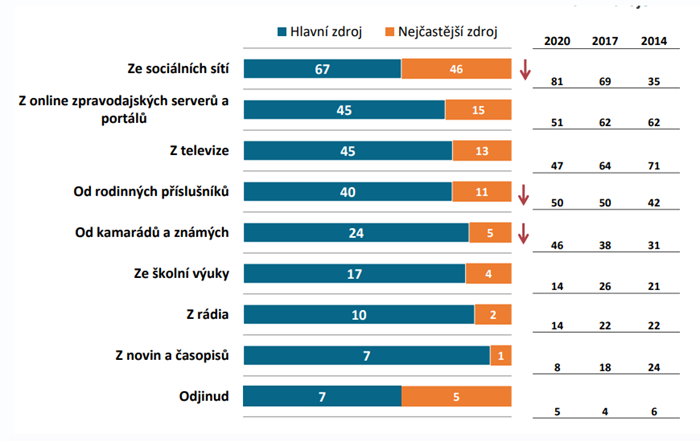Czech secondary school students do not feel very well informed. Only 45% believe they have enough information about current social and political issues. Compared to 2020, this is a decrease of ten percentage points (55% reported being informed then). The awareness of grammar school students is higher than that of pupils from apprenticeships. Half of grammar school students believe they have enough information about events. In contrast, only 40% of pupils from apprenticeships share this opinion. This is the result of a survey conducted by JSNS and the organisation People in Need, which for the sixth time surveyed the opinions and attitudes of secondary school students. It was conducted by the Median agency.
The majority of students (67%) most often get their information from social networks. However, there is a noticeable rapid decline (by 14 percentage points) compared to the previous measurement; as recently as 2020, 81% of students reported this information. Students overwhelmingly declare that they check information. In the case of information that does not correspond to their world views, 71% of students report verifying it.
 Main sources of information for secondary school students (%); Source: JSNS, Člověk v tísni, Median. N 2023 = 1193, N 2017-2020 = 1200
Main sources of information for secondary school students (%); Source: JSNS, Člověk v tísni, Median. N 2023 = 1193, N 2017-2020 = 1200Social networks are the main source for following news, used frequently and occasionally by up to 88% of high school students. This is followed by public service television (Czech Television) and then the main online news sites. However, their use as a news source has fallen by 18 percentage points since 2020. The fourth most used news source is commercial television and then blogs by various authors.
In terms of trust in the media, CT is the most trusted news source among students. Up to 63% of students trust it, while 18% do not trust it. Although the majority of students report that they most often follow news on social networks , trust in them is much lower than in other information sources. 31% of respondents fully trust information from social networks.
In terms of daily use of apps for communication, Instagram is currently the most frequent, used frequently by 86% of secondary school students surveyed. A further 8% of students use this app occasionally. More than half (55%) of students are present on social media when they cannot sleep. A similar number (52%) open social networking apps as soon as they wake up. Compared to the last survey, the proportion of students who use social networks during class has increased (33% compared to 17%).
Regarding the use of artificial intelligence (AI) in teaching, 70% of students find it beneficial, 10% do not, and the remaining 20% do not have a strong opinion. Only 12% declare that AI is already applied in teaching and are satisfied with this state of affairs. A further 8% say that they already use AI to some extent in teaching but would like to see more use.
The research surveyed other attitudes among high school students. The full study is available here.
About the survey
The survey was conducted in late 2023 among 12,100 respondents in 33 high schools across the country and offers comparisons with surveys from previous years. High school students consider the country's biggest problems to be debt, the economic situation, and poor quality education. Half of the students consider the current assistance of our republic to Ukraine to be adequate. Only 15% of high school students think that they can influence the solution of problems in their community or in the Czech Republic. The survey was commissioned by the One World at Schools (JSNS) programme of People in Need, and conducted by Median.
Source: mediaguru.cz

